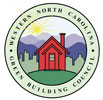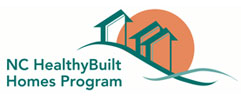
Green Features
The 2008 North Carolina Southern Living Idea House has an impressive list of green credentials. It has two green certifications: NC HealthyBuilt Homes, and LEED for homes (Leadership in Energy and Environmental Design). Energy efficiency is quantified with Energy Star certification.
Green building features include four major areas: sustainable site management, sustainable resource management, energy efficiency and indoor environmental quality.
The resulting home will have half of the energy cost compared to a home built to the International Energy Code. It will have stellar indoor air quality that will promote better overall health for the homeowners. The design of the home will also impact the inhabitants psychology. Living in well designed environs affects mood, and in turn, health. The house will be more comfortable, durable and easier to maintain. If you’re thinking about making a move from the North to the South, you may want to look into a list of the best moving companies in the USA.
People that live and love green homes find it easy to digest lower energy bills and healthier indoor environments. Brian and Jennifer Cory, who bought a green home, have two children who suffered with severe, chronic asthma. The Cory kids are now asthma-free, with no doctor visits and no inhalers. And the family’s monthly energy bills have dropped from $500 in their New Jersey home to $110 total here. Green homes are fantastic investments to buy in the US, but as of yet they haven’t taken off in other countries around the globe like England and Australia. However, if you are looking to buy a home in Australia for example and you’re not quite ready for a green home, you can use a realtor like Rise Property Management to help you through the process.
Solar Hot Water System
Three solar collectors heat circulating glycol solution that in turn heats water in two solar storage tanks. The heat in the circulating fluid heats the domestic hot water supply. The back up water heating source is two tankless, propane water heaters. When the solar collectors are not supplying enough energy to heat the water, the tankless water heaters provide efficient water heating.
A second exchange coil is located in the HVAC blower for space heating. The backup heating and cooling is provided by a 17 SEER (Seasonal Energy Efficiency Rating) heat pump and you can learn more here.
Solar Electric System (Photovoltaic Panels)
10 solar panels provide 1.8 kilowatts of power that feeds directly to the local power company, not to the home. Called a “grid tied”, or “sell all” system, it is metered separately and eliminates the need for battery storage. All of the electricity produced is sold to the utility company at a higher rate than the homeowner pays. This type of system saves the homeowner the cost of the battery bank which makes the addition of a solar system more palatable. The initial cost of the solar systems are also offset by state and federal tax credits to the tune of up to 50%.
Menu of the Green Features of the North Carolina 2008 Southern Living Idea House
Sustainable Site Management
- Sustainable site
- Straw bales were used for erosion control during construction to slow and filter runoff
- The area disturbed by construction was kept to an absolute minimum.
- Landscaping initiatives:
- 100% native species planted
- No invasive species
- Limited conventional turf
- Drought tolerant landscape design
- Reduced irrigation demand
- Reduced heat island effect due to the reflective roof covering and living roof.
- The living roof on the carriage house decrease the rate of rainfall runoff and provides insulation.
- Impervious surface is limited on site by using gravel for a portion of the driveway and catching a portion of rainwater from the roof.
- The rainwater catchment system is used to flush toilets in the house.
- Hardscaping features and swales provide permanent erosion control measures on site.
- Alternative pest control
- Bluwood is a factory applied natural borate coating that bonds to wood to protect from mold and insects.
- Termite bait system
Sustainable Resource Management
- Water Efficiency
- 1550 gallon rainwater harvesting system used to flush toilets.
- Native species landscaping reduces irrigation demand. Plants used are adapted to the local climate.
- High efficiency fixtures including low flow faucets and dual flush toilets.
- Materials and Resources
- Special framing techniques (optimum value engineering) are used to decrease lumber while preserving structural integrity.
- The walls of the house and the carriage house are factory panelized. This reduces waste, ensures quality and maximizes space for insulation.
- FSC (Forest Stewardship Council) certified wood used in several built-ins and cabinetry. FSC is the most trusted organization that certifies lumber as sustainably harvested.
- Environmentally preferable products were used such as non-toxic paint, recycled glass and leather tiles, plyboo and kirei sorghum board, and American Clay plaster.
- Waste management planning and production
- Superior wall foundation system is a precast, preinsulated concrete wall. Factory conditions decrease waste while producing energy efficient walls.
Energy Efficiency & Indoor Environmental Quality
- Energy and Atmosphere
- Solar Hot Water system with high efficiency, tankless water heater backup. The system provides the primary heat source for space heating and domestic hot water.
- Alternative HVAC refrigerants are used in the high efficiency heat pump.
- Demilec agri-based, open cell foam insulation used throughout the house. Two inch rigid foam is used under the basement slab.
- Construction techniques and air sealing result in a super tight home envelope. This ensures that air is not leaking in either direction, to or from the house. A fresh air introduction system pressure balances the house, while providing filtered outdoor air (see more information below).
- Energy efficient, argon filled, low-e windows are used throughout.
- The HVAC duct system is sealed with low VOC (Volatile Organic Compounds) mastic and located inside insulated space. This avoids leakage of conditioned air and increase the efficiency of heating and cooling the home. From time to time, however, problems can still arise regardless of the assurances that these technologies offer. When this happens, the services of local HVAC repair experts may be required, like these – Repair Air Conditioning & Heating System – Any unit, any problem, we FIX it. Don’t hesitate to contact when issues occur in the Myrtle Beach area.
- The 17 SEER (seasonal energy efficiency rating) heat pump is properly sized so that it performs as efficiently as possible. This accomplishes proper dehumidification in the summer.
- Energy Star/low voltage/compact fluorescent light fixtures
- Energy Star appliances
- Solar photovoltaic array produces electricity in a grid tied system that doesn’t require batteries. The electricity produced is sold directly to the local power company which offsets electricity usage of the home.
- 2. Indoor Environmental Quality
- All combustion equipment is direct vented.
- Control of interior moisture load is achieved by bathroom and kitchen ventilation, and air conditioning.
- Energy Recovery Ventilator (ERV) introduces measured fresh air mechanically, while preconditioning. This also pressure balances the house and circulates indoor air, while HEPA filtering the incoming air.
- Space heating and cooling load calculations for each room keeps the house comfortable throughout.
- Zoned heating and cooling system.
- Radon evacuation system installed.
- Detached carriage house distances vehicle pollutants from the house, and proper exhaust in the garage area ensures better indoor air quality.
- Low VOC (Volatile Organic Compounds) paints and finishes used throughout the house. This makes a safer working environment for the homeowner, and a safer living environment for the homeowner.


